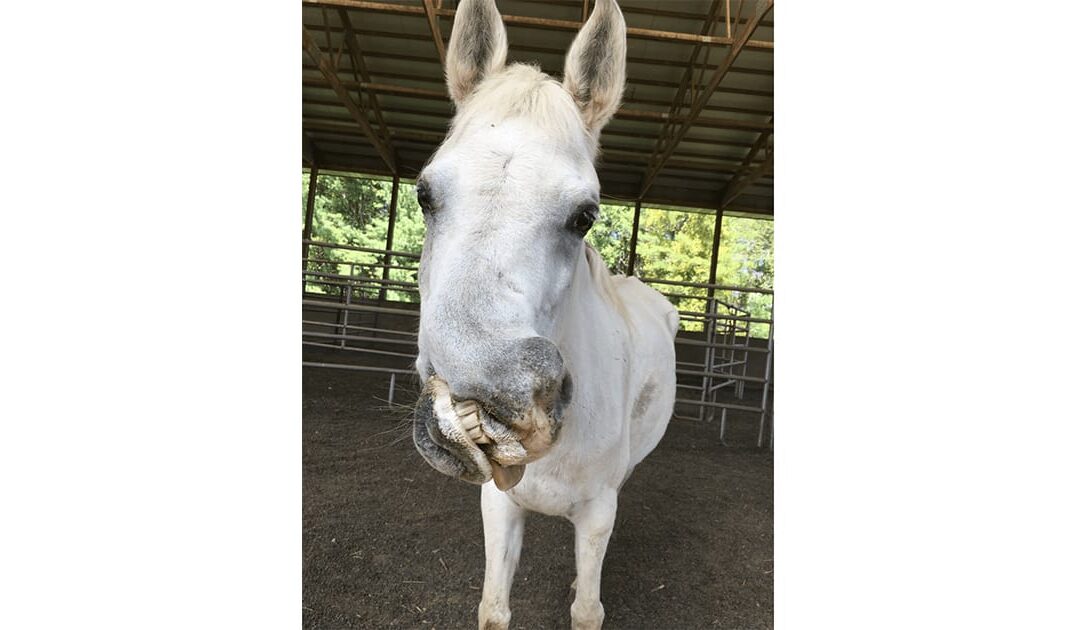
by Kathleen Choe | Jan 9, 2018 | Equine Assisted Trainings, Testimonials & Reflections
Meeting Dollface
Although I had been informed ahead of time that the white Egyptian Arabian mare we were working with for our Natural Lifemanship Intensive Training had some facial deformities and neurological issues, I was surprised by the strength of my visceral response when I actually saw her in person for the first time. She snorted through one working nostril perched on a jaw that veered off to the left, leaving her tongue dangling with seemingly no place to rest. Her face just looked so . . .wrong. I felt a variety of emotions: pity, sadness, alarm, revulsion and a desire to turn away, layered with shame and self-condemnation for my instinct to do so. I was both amused and repelled by her name: Dollface. It seemed to draw attention to her deformity without dignifying it anyway. The training participants gave a collective gasp as they approached her pen, and began murmuring among themselves. I knew working with Dollface would challenge all of us in interesting ways. I was curious how her physical appearance would influence how both the horses and humans involved in the training responded to her. Over the course of the training I observed the following:
-
Over-compensation for a perceived disability
Many people were afraid to approach Dollface or make relational requests. They felt pity for her and didn’t want to make her uncomfortable or challenge her. “Her life is already hard enough,” was a prevailing sentiment. Giving Dollface a pass on taking responsibility for herself had led to a series of behaviors that were damaging her relationships. She was pushy, demanding, and reactive when approached or touched. She clearly wanted to engage but did not know how to do so in an appropriate manner. This left her without the friendships she desired, both from horses and humans. People with disabilities or special needs often report that others make false assumptions about their intelligence or capacity to interact “normally” and treat them like children, speaking slowly and carefully, avoiding eye contact, and acting in a generally uncomfortable manner.
-
Lack of acknowledgment
In an effort to not treat Dollface differently, some people went to the other extreme of acting as though she was the same as the rest of the horses, hiding or denying any internal discomfort or uncertainty about how to approach her. This set up an emotional incongruence that felt unsafe and confusing for Dollface. She was different. Her appearance did take getting used to. Horses are prey animals, and experience an incongruence between our inner emotional state and our exterior presentation as dangerous and possibly predatory. Acknowledging the reality of the situation and any discomfort we might have about it is an important first step to proceeding in a way that is healthy for the relationship. We first have to become aware of and accept our own prejudices and preconceived notions before we can work on changing them.
-
Making assumptions
Dollface had experienced some early trauma besides being born with a facial deformity. She was removed from her home after a murder-suicide by a rescue organization that cared well for her physical needs but expected little from her in terms of appropriate behavior due to her history and disability. Because little was expected, little was required, resulting in what you would expect from a spoiled child: selfish behavior. Although this might look like kindness on the surface, horses and humans who are entitled and selfish do not have mutually satisfying relationships. They are tolerated rather than enjoyed. At first I heard a lot of reasons why Dollface shouldn’t be asked to do much relational work in the round pen due to being tired, overwhelmed, or uncomfortable. When people stopped making excuses for Dollface and began asking her in a predictable, consistent, patient manner to stop squealing, biting and being aggressive, she became more regulated and able to connect relationally in delightful ways.
-
Differences in acceptance between horses and humans
Initially, I wondered how the horses might react to having Dollface in their midst. Only one of them had been with Dollface prior to the training. For the rest of them, she was a newcomer, so I was curious if they might perceive her birth defect as a threat to the safety of the herd. Horses depend on every member of their herd to be appropriately in control of themselves and aware of potential predators and other threats so that collectively they can maintain safety. None of the horses seemed to notice that Dollface was a bit different from them. Other than a bit of interest from one of the geldings when he discovered Dollface was in heat, they treated her exactly as they did each other. They expected her to behave like an appropriate herd member, and let her know when she did not.
-
Differences in self-acceptance
Apparently, no one ever told Dollface she was different. She saw herself as a completely normal and functional horse. She did not hide herself from either the people or other horses at the training. In fact, her behaviors involved attention seeking; she was not shy about demanding that we spend time with her. She had learned to eat, drink water, breathe and move with her twisted jaw and now that she was learning some relationship skills was also learning to make friends and have mutually satisfying connections.
By the end of the training, we had overcome our reservations about working with Dollface. Our prejudices and fears had been challenged by her self-confidence and insistence that we treat her like a normal horse. One of the participant’s re-named her Hope. That seemed much more fitting for this spunky, endearing, feisty survivor.
An Experience of Connection Over Prejudice Video
Sign up for our Relationship Logic Immersion training at Horse Sense of the Carolinas September 7th-9th, to get an opportunity to work with an untrained horse like Luna (her new name!). The horses at this training are rescue horses that have a story and a past – we hope to positively contribute to their successful placement in a “Forever Home” by helping them develop needed emotional and relational skills. Through this process, participants can deeply internalize NL principles of connection and learn how these transfer to human relationships, including the therapeutic relationship and process. There is a possibility that Luna, will be participating in the training.
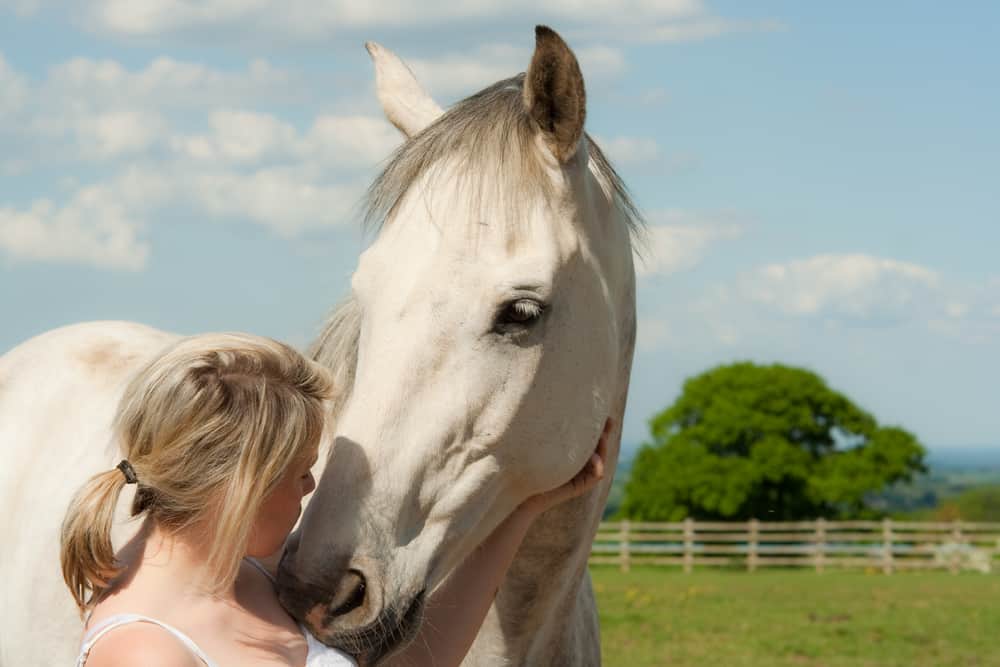
by Amy Nistor | Jan 9, 2018 | Testimonials & Reflections
…A Personal Experience with Natural Lifemanship
As I entered the 2017 Natural Lifemanship Conference I felt very small, and insignificant compared to others there. I felt the need to make myself humble, kind and help out to be seen by others. This was the agenda of my 4yo little girl self that insisted that she must sacrifice her own needs, thoughts and ideas and voice to meet these things in others in order to get attention. She believed the only way to get attention and love is by catering to others and sacrificing yourself.
During the conference, I was fighting to be true and authentic and not fall into this agenda to get attention through submission. As I did so, the tension in my shoulders increased throughout the day. A self-regulation exercise at the conference revealed the tension in my shoulders was connected to the 4-year old self. She was pressing hard onto the upper portion of my right shoulder to cause me to submit, cower down and be passive to others at the conference and I was trying to resist her insistence. She wanted me to accept her way to protect me from getting hurt and trying to connect in the only way she knows how through submission. At that moment, I just assured her that I love her, I see her. I explained inwardly it’s safe to explore a new way, but the sharp pain of pressure in my shoulder remained.
Later that evening after the day was done I found a quiet spot to put on my bilateral nature sounds and focus in on my little girl and that pressure in my shoulder. Quietly and with love I entered into how scared and terrified she was. How she was trying to protect me and help me get attention in the only way she knew how and I was resisting her. I just sat in the rocking chair and loved her, held her, rocked her in that terrified-place she was living. I explained to her this new community of connection the NL community offered is pure and allows her
to be completely herself and that she doesn’t need her old ways of cowering. At this exchange, a deep rumbling of weeping arose within my chest. It rose and fell like waves rising and crashing at a deep place within my core. At the same moment, a great sense of gratitude fell over me. I was grateful with all my being to be now offered the love I always deeply desired.
Though my heart desperately had looked for love all these years, I came to rest on the truth that what I was truly seeking was true, pure, connection that sought good for both in the relationship.
That night at the NL conference demonstration, Tim showed with the horse, Jack, how he gently invited the horse to a pure, true connection that offered good for both in the relationship. It was clear from watching how safe and secure that invitation was. I realized that was what Tim offered me that day in February 2017 at the NL Fundamentals Training during the Rhythmic Riding demonstration. Tim offered me a true, pure connection that didn’t take from me, nor demand any part of me that met his needs. He offered me a
connection that had my back, that held me as the horse did and if I couldn’t connect with the horse, it was ok, he would connect and hold the horse. I only had to connect to me and my deep grief. The grief of having no support for so long and the deep desire to be seen and connected. It was there in that moment with a gentle hand on my leg his touch said, “I see you, I’ve got you, it’s ok, just let go and be held.” When I connected to myself and what I was feeling, it was then that the horse met me there with connection and held me from
beneath. I was not alone. I was held by this beautiful horse that carried me on his back and a man that didn’t take from me but offered to be my strength and stability while I fell apart.
That experience was so terrifying, but so deeply satisfying at the same time. I wanted to run from the eyes and attention of everyone that was holding me at that moment. I was so fearful it would turn against me, but it DID NOT, the care and connection were true and secure. That secure holding experience just made me cry deeper in grief of not having it for so long. Now at 40 years of age, I was being offered it freely by a tender, strong and loving cowboy, a beautiful horse, and a crowd of strangers that desired the same kind of connection.
After the NL demonstration at the Natural Lifemanship conference that night, I rocked that scared 4yo inside of my heart. I cried and cried with the grief of so much time gone by without a secure connection and yet I was overflowing with gratitude my body felt it could not contain. With bilateral nature sounds in my ears, chest heaving, tears falling and body rocking, Texas raindrops began to fall on me. I felt as if a deep cleansing and filling was happening as I received the pure connection this community offered and all of me moaned and cried with gratitude. I sat in that place for a long time. Suddenly out of nowhere, I felt a pop in my shoulder and the pressure that 4yo girl held on me was released. With clothes damp and rain diminishing the thunderous shaking within me softened and became like a soothing lullaby. My eyes closed and a soft sadness fell from that little girl inside. She realized her attempt to protect me had hurt me and kept me from connecting truly with others. With soft whispers and loving kindness, forgiveness and grace was exchanged. Peace within us was found and connection deepened to a quiet place.
As I looked out into the darkness of that cool Texas night I felt a nearby presence that approached more as I moved through this inner exchange. In this quiet place, I realized it was the paint horse I met in the pasture the day before. He was the lowest in the herd and approached them with a fearful submissive stance. I noticed his position then and my 4yo little girl could relate with his position and loved him for it.
That night as inner peace was found, this paint horse stood nearby in the pasture, almost there to acknowledge and honor the little girl he met the day before. I was drawn to get up and go near the fence and show my gratitude for his appearing. As I walked in the darkness in his direction I could feel my attention on him made him uneasy. In honor of his concern, I turned my body parallel to him and looked away, yet stayed connected to him in my heart. I knelt toward the grass to make myself even less threatening and listened as He grazed even closer to me. My little girl self so wanted to have a physical contact with him, but inwardly extended honor and gratitude for him seeing her and honoring her at her most vulnerable.
In desperate waiting for more closeness, out of the darkness the black lead mare ran between us and moved the paint horse far away from me. At that moment, my little girl fell away and my adult self stood up and appeared along the fence. I was shocked and saddened, but also realizing that black lead mare just gave me a precious gift. She reminded me I am no longer a scared submissive little girl, I am a confident and beautiful woman that doesn’t need sympathy but encouragement to move forward, walk boldly and be me. As I made my way to the bunkhouse and prepared for bed that night, I heard a whinny out in the pasture. I felt called to meet it. When I arrived at the fence the black lead horse stood close to the fence and grazed while I stood beside her. Her presence assured me, all was ok and I did not need reassurance from anyone that my experience and my healing release needed validation. All was good in the pasture and she was calling me to graze on and just confidently be me.
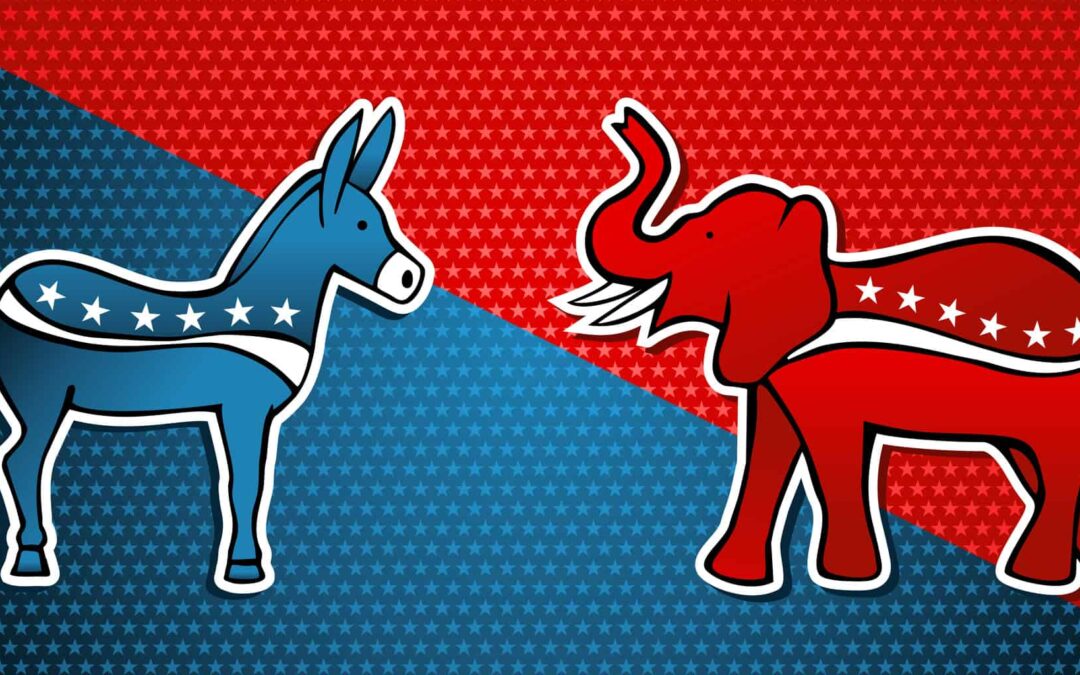
by Rebecca Hubbard | Jan 6, 2018 | Applied Principles
…Think About It
I woke up this morning and wondered what it would look like if our political parties used the principles of Natural Lifemanship to interact with each other and to do business. Think about it.
What if each party attempted to meet both their own needs and the needs of the other party?
What if each party cared about and worked for compromise and equality in their partnership?
What if each party truly understood that if it is not good for both parties, it ultimately is not good for either party? What if they responded appropriately when the other party “moved their feet”?
What if each party created space for the other party to make choices that are best for both parties? That neither party took away the choices of the other party and neither tried to control the other?
What if both were careful with their verbal and nonverbal communications with the other?
What if it were safe to make mistakes, disagree, and openly and honestly communicate ideas, needs, and beliefs?
What if each party appropriately controlled itself, and made choices using their whole brains?
What if each party respected the other party and was able to set and accept limits?
What if each party was assertive in their communication and actions and not passive or aggressive?
What if both parties were able to use the principles of pressure appropriately? That is, each party increased the pressure when the other party was ignoring. Each party maintained the pressure when the other party was resisting, and each party released the pressure when the other party was cooperating?
What would it be like?
What might we accomplish?
Rebecca J. Hubbard writes stories for children and is a master’s level licensed marriage and family therapist in Texas specializing in equine-assisted psychotherapy. More information can be found at www.rebeccahubbardlmft.com
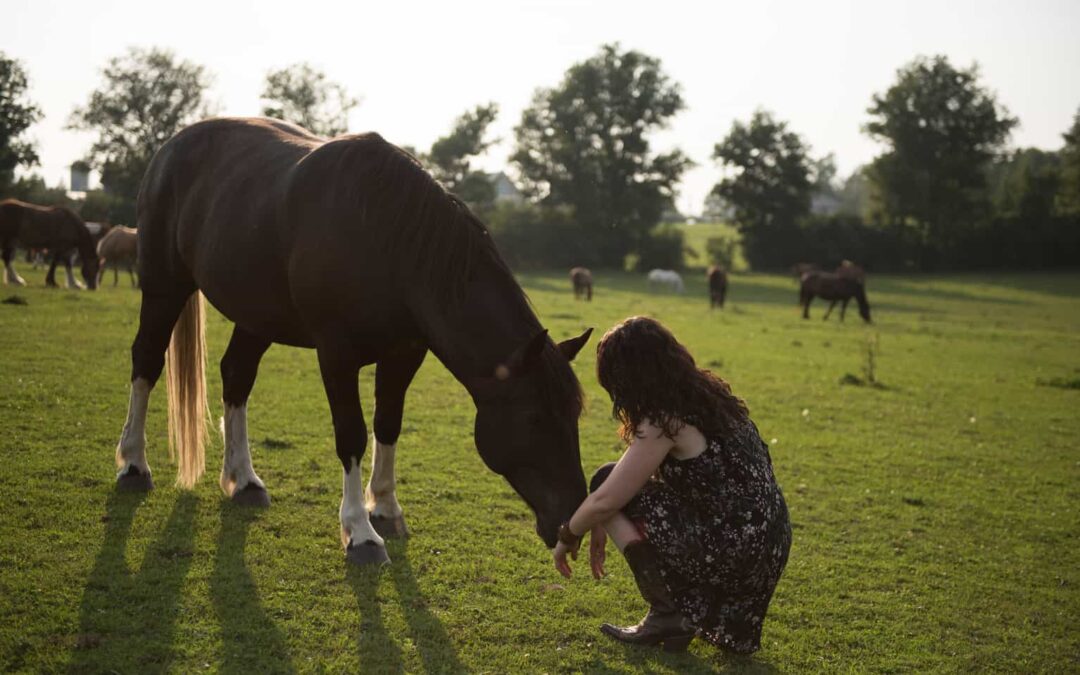
by Sarah Schlote | Jan 4, 2018 | Horsemanship, The Latest in Equine Assisted Therapy and Learning
July 1, 2021: It has come to our attention that this blog post is being misused on Twitter to justify animal abuse.
******************************************
Can Animals Consent? By Sarah Schlote
This interesting question, which came out of a post I shared on Facebook (here and here) about a yoga on horseback video that went viral recently, elicits differing opinions. Some claim that consent is a human construct linked to morality, and therefore cannot apply to animals philosophically or legally (calling it anthropomorphism). Others claim that since all mammals share a similar neurobiology, responses to safety, danger and life threat, experience emotions, are sentient and perceptive — and that since both human and non-human animals can express “yes” and “no”, aversion, attraction, fight, flee, freeze, fawn, collapse, submit, and make informed choices — they can indeed “consent” or not (in their own way). This second group suggests that to deny animals the ability to consent is anthropocentric and can be a way to justify the exploitation of non-human animals for the benefit of people.
This article certainly will not resolve this debate, and its goal is not to malign or shame any particular horsemanship discipline, method, or equine-assisted intervention approach. Rather, I hope to invite curiosity and offer a different lens in a spirit of gentle openness and non-judgment about ideas that, while controversial, are nonetheless important to reflect upon.
The word consent means to permit or allow. Barbara Rector, one of the pioneers in the field of equine-assisted practice, understood the notion of consent in relationship with horses. Her exercise, Con Su Permiso, which means “with your permission” in Spanish, speaks to the idea that animals can communicate consent or permission through their body language and that healthy relationships are built on a foundation of mutual respect. Words are not the only way to express when something is a “no” or a “yes”, and Barbara is not the only person championing the idea that horses (and, indeed, mammals in general) can express permission or objection through their body language, of course. But, even so, this idea is not consistently applied in the field of animal or equine-assisted interventions.
A common statement heard in the industry is that the horses are always free to move away if they ultimately do not want to take part in something. However, what is the interpretation if they do not move away? Is it always because they are choosing to stay willingly and without coercion? One might not move away but show other signs of “not wanting to be involved” that are often missed or dismissed. Does that mean that someone (human or animal) who goes into submission, freeze, or collapse in the face of something they don’t want to do or experience is consenting? Shutting down technically is “allowing” something to happen on some level, but only because the other options (fighting back, fleeing) might not be possible or might lead to greater harm, punishment, pain or death. Equating “going along with” to “consent” is a very murky and dangerous proposition. There’s a distinction between being in the lower parts of one’s brain, dominated by survival physiology and reacting out of self-protection (instinctual), and being integrated and able to express conscious choice freely from one’s neocortex, when regulated and connected to self and other. And even this is not a clean dichotomy, but more of a continuum. Regardless, can consent happen when someone – human or animal – is hijacked by fear, terror, or primal subcortical self-protective responses in the face of coercion, control, threat, or helplessness? Can healthy relationships exist under those conditions? And how can there be connection in relationship without consent? Even the polyvagal theory proposed by neuroscientist Stephen Porges proposes that the capacity for social engagement and connected relationships decreases the more the nervous system is activated in sympathetic charge or in a dorsal shutdown.
Evolutionary biologist Marc Bekoff states, “over the years, I’ve noticed a curious phenomenon. If a scientist says that an animal is happy, no one questions it, but if a scientist says that an animal is unhappy, then charges of anthropomorphism are immediately raised. This ‘anthropomorphic double-talk’ seems mostly aimed at letting humans feel better about themselves” (2009). This phenomenon also occurs when people use “human” concepts like “addictions” and “neglect” when referring to other mammals, instead of sterile words like “stable vices” and “deprivation” which minimize and deny that non-human animals also sense and cope with pain and distress in ways that are remarkably like our own. The same also happens when discussing other animal emotions, in spite of the evidence from the field of affective neuroscience, or even when wanting to use the word “trauma” in relation to non-human animals, a leap many are still reluctant to make. The same can be said for extending the idea of consent to non-human animals as well. This does not mean that there are no differences between humans and non-human mammals, for indeed there are. But all too often a false dichotomy between us and them is created that seems to promote the status quo, rather than face the cognitive dissonance or discomfort that comes when recognizing the impact of one’s actions on others.
The following quote aligns particularly well with this trauma-informed perspective:
“Like many vulnerable humans, animals are capable, though often deprived, of making informed decisions about their lives. Animals can express assent and dissent, but we rarely respect their personal sovereignty in ways that acknowledge their aptitude for making choices. Play and cooperation among animals are examples of how animals can express consent with one another, but we don’t speak the languages of other animals, and they typically don’t speak ours. Even when they express dissent to us, their feelings are often ignored. The ways animals are exploited in research, entertainment, food and clothing production, and other areas of human society clearly defy their sovereignty – much like human exploitation does, suggesting that something much deeper is at work here. In addition to the physical violence animals suffer through, they also suffer from fear, anxiety, and depression – like we do – when their personal sovereignty is violated.” –Hope Ferdowsian, MD, MPH
If saying the word “consent” is still too politically laden, too controversial or too far of a mental leap to make, then using “assent and dissent” still conveys the underlying point. Anecdotally and the research shows that mammals – including humans and equines – are capable of choice and expressing their preferences and opinions. This does not mean that learning to tolerate things that are uncomfortable or doing things we or other animals don’t want to do does not have value. There is a need to be able to do so in life, to compromise, to do what needs to get done (even if unpleasant), such as having to do certain tasks or jobs to pay the bills, following through on commitments or requirements (work ethic), or using distraction in order to cope with an uncomfortable or painful medical procedure, for instance. But there is a far cry between getting a horse to comply with a medical practice that might benefit its own health and wellbeing in the long run, and getting a horse or other animal to comply or submit to an activity that seeks to provide some benefit to someone else at its own expense (or, at worst, causes harm to the animal).
While this issue is difficult to resolve at a macro level (such as using animals in medical testing or other industries that benefit humans – a conversation that is beyond the scope of this article), it is much easier to tackle at a micro level, such as in the field of equine-assisted practice, where partnership with a horse should be the foundation for growth and healing. If the healing, growth or enlightenment of one member of a relationship comes at the expense of another whose “no” is not being respected, what message is this conveying? How “healing” is an interaction if the needs of only one are being acknowledged or respected in the process? Doing so comes at the risk of reinforcing an unfortunate win-lose re-enactment that, ultimately, benefits neither and, at worst, is retraumatizing… something that may be all too familiar for either the horse or the human. Peter Levine, founder of Somatic Experiencing® (SE™), uses the term “renegotiation to refer to the reworking of a traumatic experience in contrast to the reliving of it” (In An Unspoken Voice, 2010, p.23). Reliving, or re-enacting, is repeating a familiar situation or dynamic without resolution. Renegotiating is experiencing a different outcome or experiencing oneself differently in a familiar situation, completing what did not get a chance to biologically complete (such as a self-protective response – the traditional definition of renegotiation within SE™) or repairing or restoring what was ruptured, such as relational trust and attunement. For instance, if one of the goals is for humans to connect with animals in a deeper way, how is this possible if the animal’s needs are disregarded in the process and they are tuned out, shut down, frustrated or merely tolerating the interaction? If one of the goals for humans is congruence, assertiveness and greater agency around voicing needs and boundaries, what is being modeled if the equines’ voice and boundaries are disregarded in the process?
It is important to acknowledge and balance the needs of both members of a relationship – even an inter-species one – especially when the relationship is purported to be the vehicle for healing. And, again, compromise and doing things we might not want to do from time to time are also necessary. But there is a difference between getting there through dominance, fear, submission, coercion, and shutdown, and getting there through mutual respect, choice, compromise, responsiveness to signs of “yes” and “no”, and connection. Offering animals choice does not inherently mean that humans have to relinquish theirs – or vice versa. Rather, it is about really hearing what is being communicated and negotiating from there in a way that honours both voices. Even if this is not always achievable for various valid reasons, aiming for win-win scenarios in human and inter-species relationships to the degree that is possible is nonetheless a worthwhile intention.
Even if equine-assisted practices are typically for human benefit, this does not mean that such programs cannot also seek to benefit the animals in some way. At the very minimum, the interaction will be neutral for the animals, and ideally both would gain from the interaction – the ethical concepts of “do no harm” and “do good” apply equally to the human client and the equines involved. The same can be said for the principles of trauma-informed care. Safety, choice, voice, empowerment, trust, collaboration, compassion – and, yes, even “consent” as defined in this article – can be applied to all those taking part, whether two or four legged, to the degree that is reasonably possible. Since these principles are foundational components of human therapy and of animal rehabilitation programs, extending them to equine-assisted practice also makes sense. After all, “a good principle is a good principle, regardless of where it is applied.”
*The word horse in this article was used to lighten the text. The points raised in this post can apply to other equines and mammals as well. Images in this article are by David Karaiskos Photography.
More information can be found at www.equusoma.com, www.healingrefuge.com, www.traumatrainings.com, www.traumainformedyoga.ca.
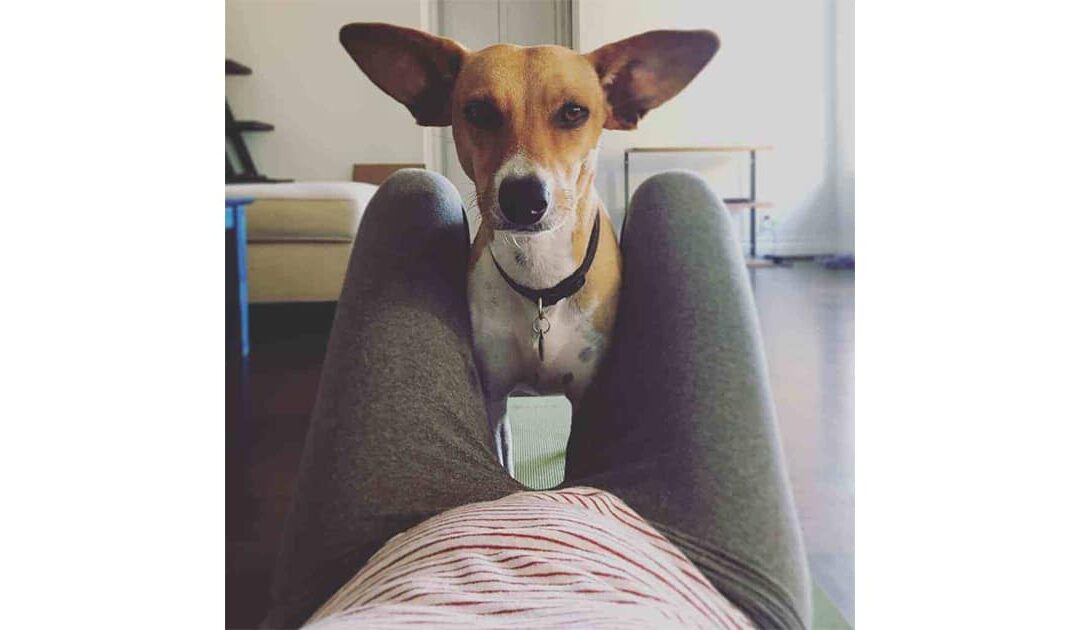
by Kate Naylor | Dec 23, 2017 | Applied Principles, Parenting and Counseling Children
Attachment Trauma
This is a story about parenting….dogs. Now don’t get me wrong – I have no intention of saying parenting dogs is like parenting kids (entirely), people are not dogs and dogs are not people. But, relationships are relationships – and if we are open to learning, we can learn MUCH from our relationships with animals.
I am a family therapist and in the last few years have ventured into the field of attachment trauma – I have learned and learned, practiced and practiced. But, it turns out; the most humbling and challenging experience for me (thus far) has been parenting a dog with attachment trauma. It makes my heart go out to those who parent children with attachment trauma – again, not the exact same thing, but, similar. Y’all, this stuff is hard, even if it is ‘just a dog’. Let me explain.
I have two dogs – Boogie and Olive. Boogie came into my life as a puppy at 8 weeks old. He started out in a loving home with his momma and has been by my side for the last 9 years. He is utterly attuned to me, cares deeply about what I think, makes requests clearly and calmly, and is easily comforted by our companionship. He is securely attached – he has no trauma around his human relationships – he is attuned and connected, easily. Olive on the other hand, was a stray. My mother took her in at her farm when she was roughly 6 months old. This is where Olive learned to play with other dogs and get along with a handful of humans; she was safe, well fed, and loved. However, she is a very different dog from Boogie. She is skittish, self-focused, is an alarmist, and warms up very slowly to new people, and only if they approach her properly. She came to live with me at about a year old, and about a year ago. She is challenging, to say the least. She is also wonderful and has stolen my heart – but that does not mean things have been easy.
So what is going on here? Why such a huge difference between the two? Olive had a warm and loving home so soon in her life – shouldn’t she adjust easily?
A disclaimer here, my areas of focus are humans and horses; but here is what I know about mammalian brains in general. They begin growing in utero, they grow in response to their environment, and they grow rapidly in the very beginning of life. In humans, 80% of brain growth happens before a child is 3 years old. Dogs grow and age exponentially faster than we do – so it would make sense that a 6-month-old dog would have experienced a significant amount of development in their brain, with much of its neural pathways already sorted out. (Especially when you think about what a 6-month-old dog is capable of, as compared to a human).
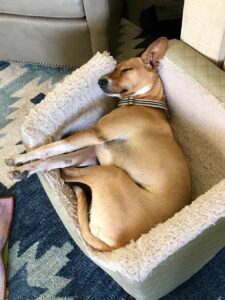 When Olive came to live with us, I spent the first few weeks feeling totally overwhelmed. I had had dogs all my life, but she was a conundrum. How can a dog be so selfish, so uninterested in my requests, so hard to soothe? Then, after too long, it hit me…duh, I have a dog with her own difficulties of attachment trauma. I had been studying this and working with families who struggled with this for several years now – but it only then occurred to me that my dog might be experiencing the same thing (it’s so easy to compartmentalize humans as being totally different from animals…but really, that’s just not the case that often). Thankfully, a light bulb went on about so many of her behaviors. For example:
When Olive came to live with us, I spent the first few weeks feeling totally overwhelmed. I had had dogs all my life, but she was a conundrum. How can a dog be so selfish, so uninterested in my requests, so hard to soothe? Then, after too long, it hit me…duh, I have a dog with her own difficulties of attachment trauma. I had been studying this and working with families who struggled with this for several years now – but it only then occurred to me that my dog might be experiencing the same thing (it’s so easy to compartmentalize humans as being totally different from animals…but really, that’s just not the case that often). Thankfully, a light bulb went on about so many of her behaviors. For example:
- Olive isn’t selfish – that’s my interpretation of her behavior. What’s really happening is she has an overdeveloped sense of survival, or in other words, the mechanisms for survival in her brain are in overdrive– so every meal, every “treasure”, every opportunity to take care of herself – she capitalizes. Survival thinking is “me” thinking – it is “how do I take care of just myself, in just this moment?” Of course she tried to eat her dinner as well as everyone else’s, and of course, she tried to horde all the treats, and push Boogie out of the way when attention was being given. She was taking care of herself, the best way she knew how. Her early experiences, likely including her intrauterine experiences, told her that survival was of the utmost importance – not relationships with others, and certainly not with humans. That only comes when survival needs are met with safety, security, and predictability. The survival, “me” focused portions of her brain were muscled up, while her relational “we” portions of her brain were underdeveloped.
- Olive isn’t uninterested in my requests – dismissing and rejecting me – she was focused on her needs and how she was going to take care of herself like she’d always done. And anyway, who was I? Some human that thought I should matter to her all of a sudden because I took her in? Humans, in general, have not been a predictable force in her life. Lately, a few had been great, but early on? As a stray I can only imagine her experience of humans – ignoring her, running her off, maybe even being the ones who dumped her in the first place. Yet, I expected her to simply trust me – based on no other reason than I thought she should. I’m pretty nice, why not? But, when people are unpredictable, the safest thing you can do is keep your distance and focus on taking care of yourself. That’s all she was doing. She doesn’t have pathways in her brain that exclaim “Yay, people!” like Boogie – her neural pathways are more likely to say, “People….hmmmmm”. So, it’s no wonder my requests were met with some dismissiveness – building a relationship in which trust goes both ways doesn’t happen overnight, especially when one party has no previous experience with trust.
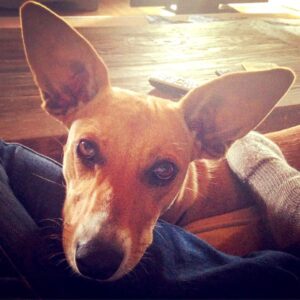 Imagine trying to ride a bike down a mountain path, when it’s your first time on a bike! You would totally fail – not because you didn’t care, but because you didn’t have the previous experience as a foundation for this new one. Neural pathways don’t change simply because circumstances change, they change over time, with practice and consistency. Just like learning to ride a bike.
Imagine trying to ride a bike down a mountain path, when it’s your first time on a bike! You would totally fail – not because you didn’t care, but because you didn’t have the previous experience as a foundation for this new one. Neural pathways don’t change simply because circumstances change, they change over time, with practice and consistency. Just like learning to ride a bike.
- Unpredictability in early life also impacts Olive’s ability to be soothed. Her life for the first 6 months, and possibly in utero as well – involved hunger, fear, and fight/flight/freeze. So her brain wired itself to be highly sensitive, highly responsive, and quick to detect threat. None of this supports a zen approach to life – it does support survival, though, and beautifully so. So
es, when a strange man walks in the house, or a big truck sits in our driveway, or we get in the car for an unknown destination – Olive is upset, and difficult to soothe. Why doesn’t my relationship with her soothe her easily? See point #2.
I cannot tell you how many mistakes I have made with Olive because I assumed she was being selfish, or rejecting, or unreasonably difficult. And knowing what I know about the brain and attachment trauma doesn’t mean I am automatically doing a better job with her. I do at times, and other times I let my feelings get the best of me. To be honest, when I really think back over all the times she and I have gotten cross-wise, most instances were my doing. Yes, she did something I didn’t like – but my impatience, my assumptions, and my big feelings are what turned a small “misbehavior” into a relational rupture. Has she been challenging? Heck yes. Has she been willfully, intentionally “bad”? Pretty much never.
We learn about each other more every day – and a year after she came into our lives she is a loving, sweet, playful friend – who also makes questionable choices and is difficult to soothe. Parenting Olive is a journey in which we both make mistakes. I am deeply grateful for the unending forgiveness she has inside of her – that fortunately, most dogs do.
The greatest lesson she is teaching me is that building a relationship with someone who has experienced attachment trauma doesn’t just take time, it takes intentionality over time. Lots of time. For she and I to be successful we need predictability, calm, intentionality, and forgiveness. Not just love – love is good, it is necessary, but it isn’t a cure all. The brain doesn’t work that way. New pathways are formed through repetition, not just good intentions.
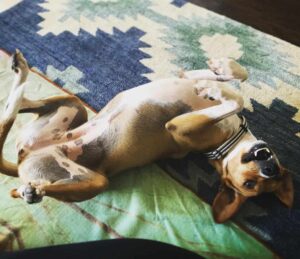
So for those of you who are loving someone (be they four-legged or two) with attachment trauma – it is hard. It is beyond words hard. Progress is slow and certainly not a straight line. And it asks a lot of us – we have to be patient, and in control of our thoughts, emotions, and impulses. But if we expect that of them, then shouldn’t we be able to do it ourselves first? And you know what, life with Olive may never be as easy as it is with Boogie.
But I noticed something the other day. When I laugh…Olive wags her tail, and when she comes bounding into a room (she is always bounding), it makes me smile. It’s a small thing, but it’s something.
Kate Naylor is a Licensed Marriage and Family Therapist in the Austin, Texas area and a Natural Lifemanship trainer. More information can be found at www.kategosenaylor.com






 When Olive came to live with us, I spent the first few weeks feeling totally overwhelmed. I had had dogs all my life, but she was a conundrum. How can a dog be so selfish, so uninterested in my requests, so hard to soothe? Then, after too long, it hit me…duh, I have a dog with her own difficulties of attachment trauma. I had been studying this and working with families who struggled with this for several years now – but it only then occurred to me that my dog might be experiencing the same thing (it’s so easy to compartmentalize humans as being totally different from animals…but really, that’s just not the case that often). Thankfully, a light bulb went on about so many of her behaviors. For example:
When Olive came to live with us, I spent the first few weeks feeling totally overwhelmed. I had had dogs all my life, but she was a conundrum. How can a dog be so selfish, so uninterested in my requests, so hard to soothe? Then, after too long, it hit me…duh, I have a dog with her own difficulties of attachment trauma. I had been studying this and working with families who struggled with this for several years now – but it only then occurred to me that my dog might be experiencing the same thing (it’s so easy to compartmentalize humans as being totally different from animals…but really, that’s just not the case that often). Thankfully, a light bulb went on about so many of her behaviors. For example: Imagine trying to ride a bike down a mountain path, when it’s your first time on a bike! You would totally fail – not because you didn’t care, but because you didn’t have the previous experience as a foundation for this new one. Neural pathways don’t change simply because circumstances change, they change over time, with practice and consistency. Just like learning to ride a bike.
Imagine trying to ride a bike down a mountain path, when it’s your first time on a bike! You would totally fail – not because you didn’t care, but because you didn’t have the previous experience as a foundation for this new one. Neural pathways don’t change simply because circumstances change, they change over time, with practice and consistency. Just like learning to ride a bike.

Recent Comments